Space shuttle Endeavour is getting its own grand museum in L.A., displayed in launch position
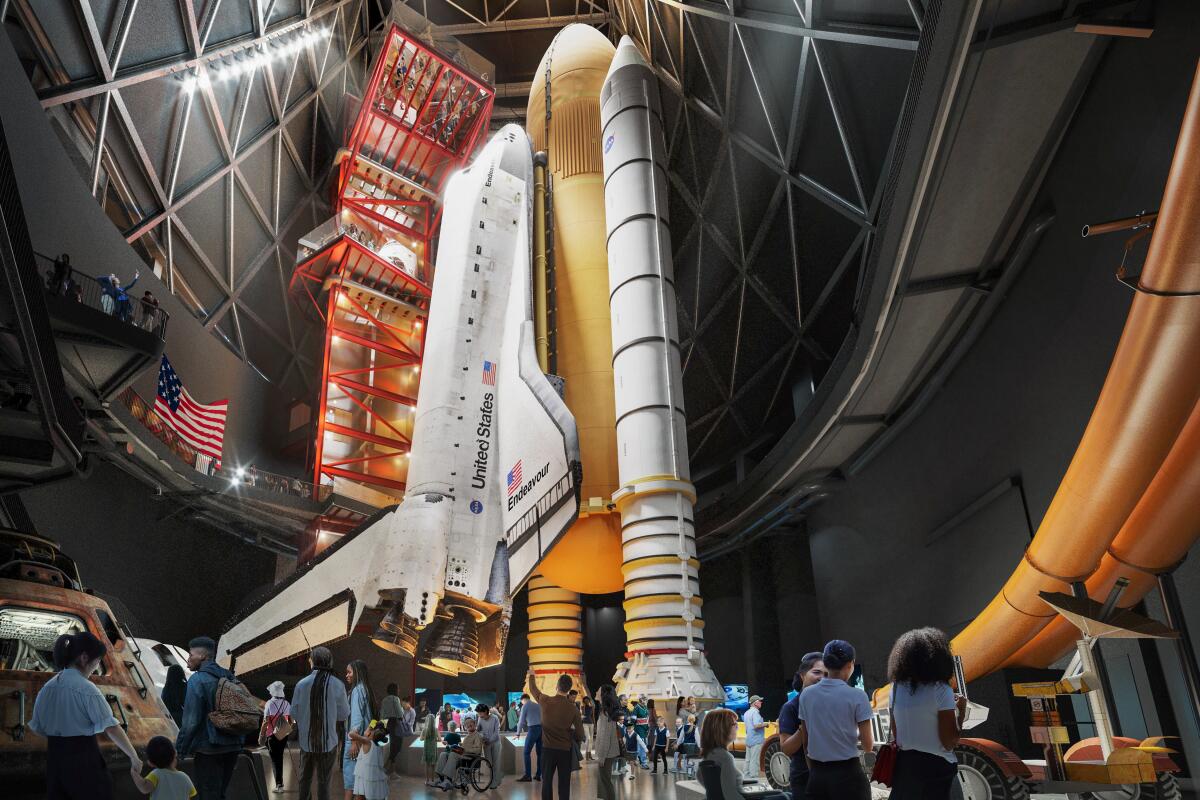
- Share via
In a milestone, the Los Angeles home of the retired space shuttle Endeavour broke ground Wednesday on a permanent museum, which ultimately envisions the spacecraft displayed as if ready for launch.
Of the three surviving space shuttles, Endeavour will be the only one displayed with its nose pointing to the stars, and will be fully attached to the last remaining authentic orange external fuel tank and twin solid rocket boosters.
Once complete, the exhibit will be what’s believed to be the tallest vertical authentic spacecraft display in the world. Building construction of the California Science Center’s Samuel Oschin Air and Space Center will probably take three years, but it will take longer for the interior to be completed. An opening date has not been announced.
The process will be complex. Roughly halfway through the building’s construction, the shuttle will be moved into the structure, and the rest of the building will then be finished.
Astronauts have cheered the Science Center for designing the exhibit so that people will be able to see the last space shuttle ever built in a way relatively few have seen it before.
“It’s gonna be pretty impressive,” Greg Chamitoff, a former astronaut who flew aboard Endeavour twice, including on its last flight, said in an interview. “When you see the shuttle on the launchpad, and you’re standing below it — it’s just a spectacular perspective.”
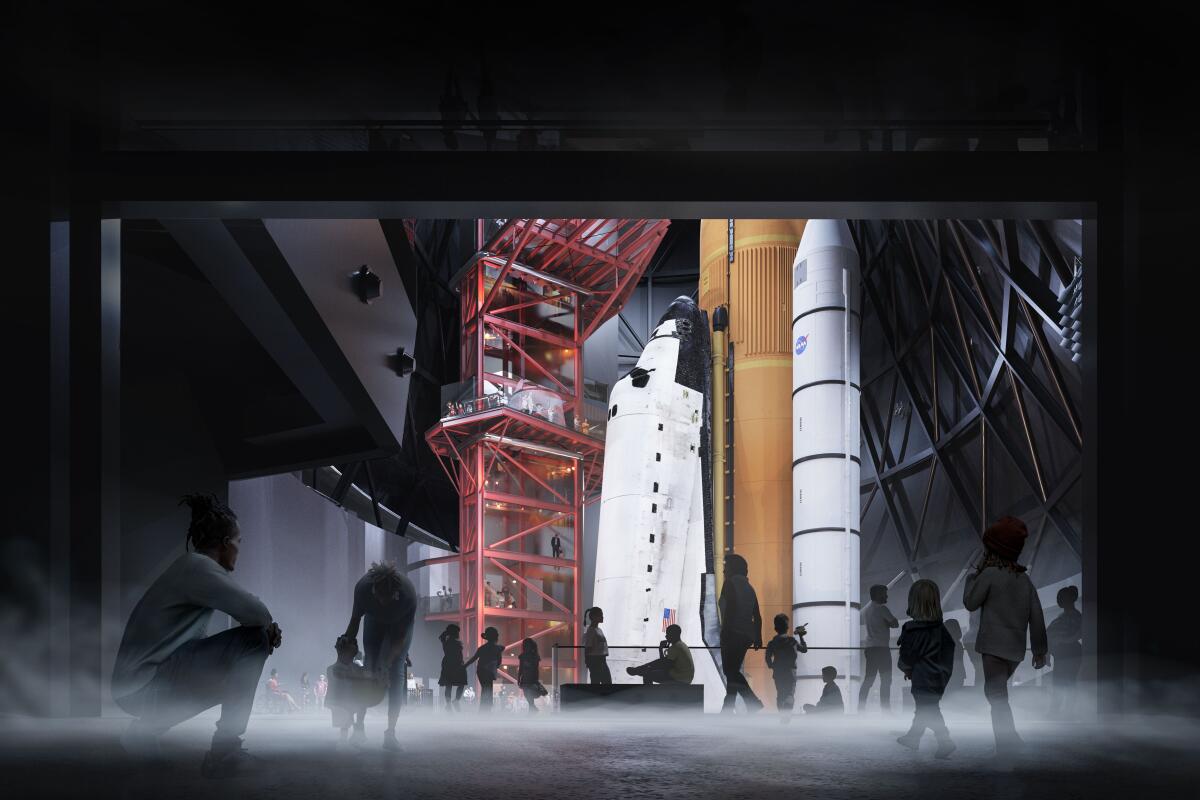
Most people who witnessed shuttle launches did so from a vantage point miles away, California Science Center President Jeffrey Rudolph said, rather than up close.
“That’s the view we’re gonna give people — like, they’re right at the base of the launchpad looking up at this shuttle stack. And it’s almost overwhelming how huge it is,” Rudolph said. “And that, I think, will inspire so many people. There are a few experiences like that around the world where you see something of that scale, that’s real, and that’s been so significant to our exploration of the universe.”
The overall exhibit will be far more dramatic than the current temporary exhibit, where Endeavour is displayed horizontally, as if it has just landed. Although the reusable shuttle is already 122 feet long (around the same length as a Boeing 737) the external fuel tank is even longer — at 153.8 feet long, taller than a 15-story building.
With the addition of the twin solid rocket boosters and the fuel tank, the overall look when added to the shuttle itself will appear “more than double that size. And then it’ll be disappearing from you, up into the size of a building. It’s going to be pretty impressive,” Chamitoff said.
Chamitoff said he thought the exhibit would be more dramatic than, for example, exhibits showing the Saturn V rocket that launched astronauts on the Apollo program to the moon, which are mostly just fuel tanks, with only a tiny proportion of the spacecraft returning to Earth. There are three remaining authentic Saturn V rockets on display, and all are displayed horizontally.
“Whatever capsules are flying today, whether it’s Russian or SpaceX, you can fit three of them inside the shuttle cargo bay,” Chamitoff said. By contrast, with the space shuttle, “so much of the vehicle makes it into space, and then back down to the Earth.”
“It was an amazing thing that we were flying. And it’s really sad that we’re not able to keep flying something like that,” Chamitoff said.
Part of the reason no other museum has displayed a space shuttle or Saturn V rocket vertically is the enormous cost and technical difficulty in doing so.
To house Endeavour as if it’s preparing for launch, the Samuel Oschin Air and Space Center will rise 20 stories. Designing the building was a challenge: A typical building of that size has floors, walls and columns. But displaying an entire space shuttle requires a structure with an open interior, Rudolph said.
“We didn’t think about doing it the easiest way to display this,” Rudolph said. “We thought about what would be the best way to display it, would have the most impact on everybody who sees it, but particularly young people, and create that spark that makes them dream and think that someday they want to be on a spacecraft like this, or participate in building one.”
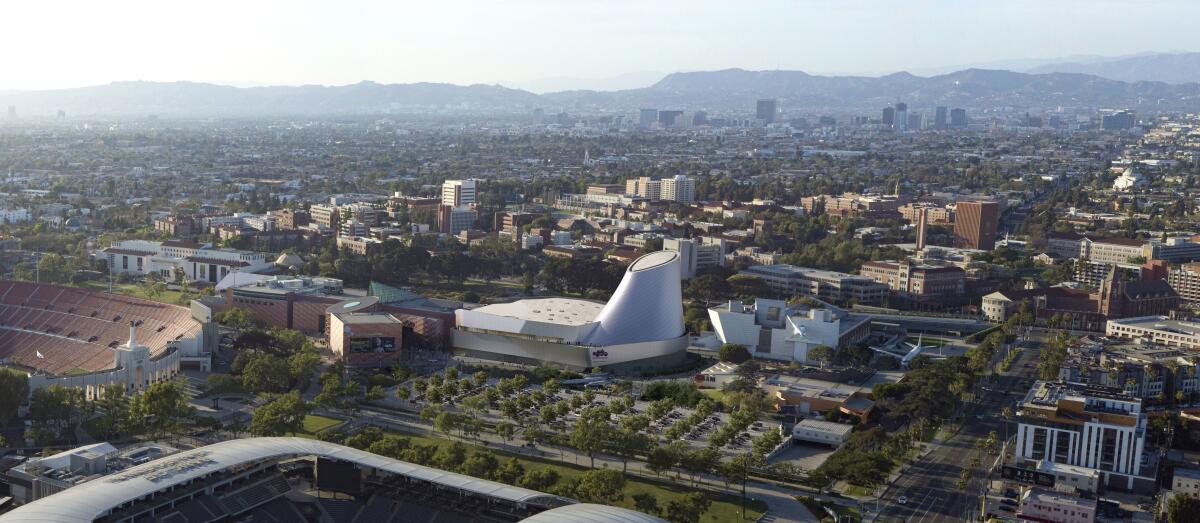
Once a lower portion of the building is completed — which will take about a year and a half — the shuttle will be installed in a process that will probably take three to four months, Rudolph said. The assembly will begin with the solid rocket boosters, then the external fuel tank, then the shuttle, completing what’s known as a full space shuttle stack.
It’ll be the first time a shuttle designed for space has been assembled vertically outside of Kennedy Space Center in Florida, Rudolph said. (The test orbiter Enterprise, which never flew in space, was assembled once in a vertical full stack at the Marshall Space Flight Center in Huntsville, Ala., and one other time at Vandenberg Air Force Base in Santa Barbara County.)
Once the building housing Endeavour is completed, additional aircraft and spacecraft will be moved in, and museum officials are still working out how long that will take. There will be three multilevel galleries in the aerospace wing — one each for air, space and the shuttle — that’ll cover four floors.
Among the new exhibits will be the forward 50 feet of a Boeing 747 — which includes the distinctive hump — that is being given to the Science Center from Korean Air.
The shuttle project, estimated to cost $400 million, will reshape the skyline of the community just south of downtown Los Angeles that’s home to the California Science Center, a state-run museum with free admission whose roots stem from 110 years ago, as a site exhibiting agricultural and industrial projects. The site became the California Museum of Science and Industry in 1951, and reopened as the California Science Center in 1998.
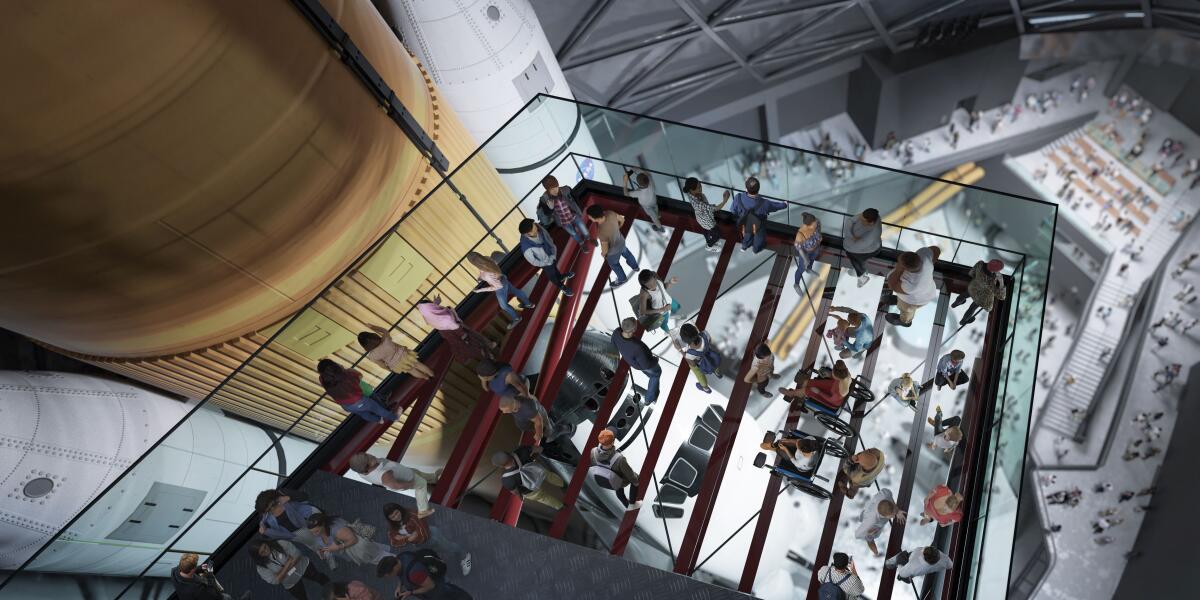
Thus far, donors have committed $280 million to build and sustain the new museum wing; the remaining $120 million will be raised over the next several years, the museum said.
The new aerospace museum wing is named for Samuel Oschin, the late Los Angeles businessman and philanthropist, whose name is also on the Griffith Observatory planetarium and the Cedars-Sinai Medical Center cancer institute. Financial contributions that came from the Mr. and Mrs. Samuel Oschin Family Foundation have been transformational to getting the new museum built, museum officials said.
The wife of Samuel Oschin, Lynda, had the honor of officially commencing the ceremonial groundbreaking Wednesday, lifting a traffic sign with the word “Go!” and then saying: “Let’s start drilling.” Two former astronauts joined Chamitoff for the ceremony: Barbara Morgan, who became the first teacher in space, flying aboard Endeavour in 2007; and Garrett Reisman, who has flown on all three surviving shuttles.
Also at Wednesday’s groundbreaking was fifth-grader Ken Sanchez, 11, one of 20 students from the neighboring Dr. Theodore T. Alexander Jr. Science Center School who provided scientific and space-based presentations. He said he has dreamed of “becoming an astronaut his whole life,” and eagerly showed Morgan how, wearing space gloves, he could handle liquid nitrogen that was minus-321 degrees.
He dunked usually bouncy tennis balls into the cryogenic fluid, and then pulled them out, each appearing like an orb as sturdy as a brick. “Sometimes you’re in class and talking about things in science that seem so far away,” Sanchez said. “Then you have an astronaut and you’re using space gloves and it’s all cool.”
Morgan, 70, a former elementary school teacher from Fresno, was just as impressed with Sanchez.
“It was so much fun to see them take ownership of their learning and … their enthusiasm for science,” Morgan said. “The old-timers like me are on the way out, but our hope is to inspire the next generation.”
Reisman said that growing up, he didn’t know what he wanted to be, but that changed with a visit to the Smithsonian’s National Air and Space Museum.
“A visit to a place like this can change minds, as it did for me,” Reisman said.
Endeavour has been in a temporary display building at the California Science Center for the last decade. In 2012, Endeavour made its final cross-country journey, captivating millions of Californians as it flew atop a Boeing 747, flying past the Golden Gate Bridge and Hollywood sign, before eventually undergoing a three-day, 12-mile trek over the 405 Freeway and across the streets of Los Angeles and Inglewood to its new home.
The 15-story orange external fuel tank arrived in 2016, on a journey by sea through the Panama Canal and into Marina del Rey, before also lumbering through the streets to the Science Center. The solid rocket boosters have not yet arrived at the Science Center, and are being stored at another location.
The space shuttle’s arrival in California was a homecoming for Endeavour, which rolled off Rockwell International’s production line in Palmdale in 1991, replacing Challenger, which exploded after launch in 1986, killing the seven aboard. Southern California played a crucial role in the shuttles’ development, which pumped hundreds of millions of dollars into the economy and became a source of pride for the region’s aerospace industry.
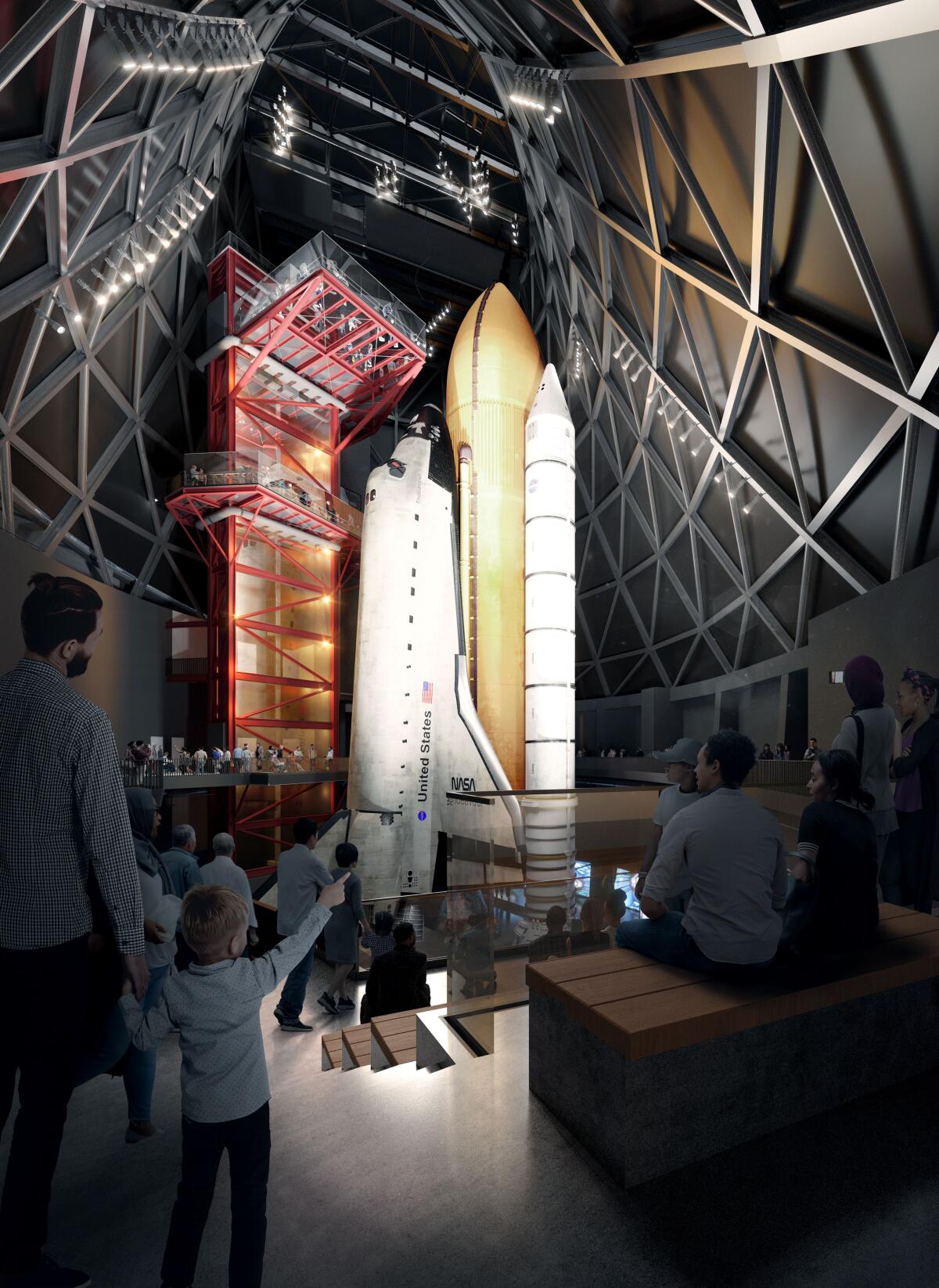
The idea of bringing a space shuttle to the Science Center has been on the drawing board for a generation. Ken Phillips, the aerospace curator of the California Science Center, in 1991 made a proposal to acquire a space shuttle at some point when they’d be retired, and in 1992, Rudolph had blueprints showing a retired orbiter perched upright.
The space shuttle program was launched following the Apollo-era mission to land on the moon. In developing a reusable spacecraft with a huge cargo bay, the space shuttles were instrumental in constructing the International Space Station, which began a decades-long stretch of human presence in space — so far uninterrupted — since its first long-term residents arrived in 2000.
Hopefully, Chamitoff said, “from that point on, humans will always be living in space, and not only be limited to planet Earth.”
The shuttle program was set for retirement after another shuttle, Columbia, disintegrated on reentry in 2003, and NASA reprioritized missions to complete construction of the International Space Station. Endeavour’s final landing from space was exactly 11 years ago Wednesday, commanded by astronaut Mark Kelly, now a U.S. senator from Arizona; only one more shuttle flight flew afterward, Atlantis, which concluded the 30-year space shuttle mission.
NASA has since developed the Artemis program to return astronauts to the moon later this decade, which would be a stepping-stone to missions farther away, including Mars. Goals would be to build a spaceship in lunar orbit called Gateway, where astronauts would be able to conduct research and take trips to the moon’s surface; and to build Artemis Base Camp on the moon’s surface for astronauts to live and work.
“What’s coming is just incredible,” Chamitoff said. “It’s very exciting going back to the moon, building permanent facilities and starting to learn what it’s like to live and thrive on another planetary body.”
Chamitoff said he hoped the Endeavour exhibit will be inspirational to schoolchildren. The Canada-born astronaut spent a number of years of his youth in California, graduating from a high school in San Jose in 1980 and earning an electrical engineering degree at Cal Poly San Luis Obispo and an aeronautical engineering degree at Caltech, before earning a doctorate in aeronautics and astronautics at MIT.
So what’s the advice he’d give to schoolchildren wanting to become an astronaut someday?
“Follow your passions... The thing that is easiest to do is to work hard on the things that you love,” Chamitoff said. “There’s so many different fields that contribute to space exploration, whether it’s engineering or any kind of science; it could be medicine.”
“The main thing is to just, you know, when you decide to do something, do it to the best of your ability. That’s what’s gonna get you there,” Chamitoff said.
More to Read
Sign up for Essential California
The most important California stories and recommendations in your inbox every morning.
You may occasionally receive promotional content from the Los Angeles Times.












